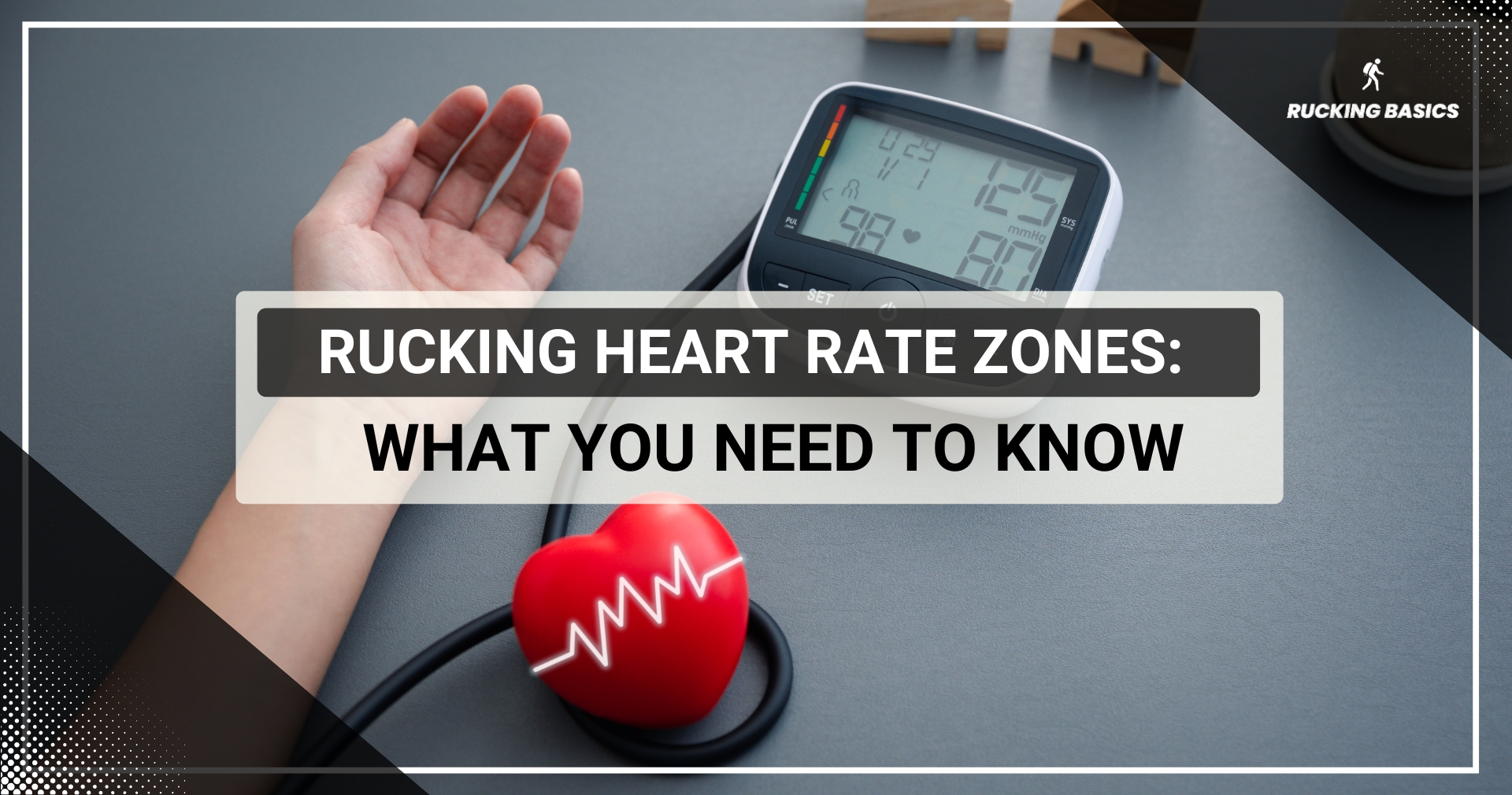I spoke with numerous fellow ruckers, and many of them think that monitoring heart rate zones is only for fitness enthusiasts and athletes, not for rucking, hiking, and other similar activities.
It is wrong to think so, and I can explain why. Early on, I believed going harder was the key to progress, often ending up exhausted and frustrated. Even though I have significant experience in sports like tennis and basketball and thus understand heart rate zones, I made a mistake with rucking — I don’t know why, but I thought it was different for some reason.
Once I started paying attention to my rucking heart rate zones, everything clicked. Suddenly, I could pace myself better, recover faster, and even enjoy the rucking session more.
I like to think of heart rate zones as a roadmap. By staying in the right zone, you can improve cardiovascular health, increase caloric expenditure, or push your limits — without risking burnout or injury. I’ll share what you need to know about zones to level up your rucking.
Heart Rate Zones 101
Heart rate zones are simply ranges that indicate how hard your heart is working during cardiovascular exercise. These zones, divided into five levels, help us measure workout intensity.
- Zone 1 (Very Light): 50-60% of your max HR. This is the easiest intensity level, ideal for warm-ups, cool-downs, or active recovery. It’s also where beginners often start.
- Zone 2 (Light): 60-70% of your max HR. Known as the “fat-burning zone,” this level is excellent for improving endurance while staying at a comfortable, sustainable pace.
- Zone 3 (Moderate): 70-80% of your max HR. Often called the aerobic zone, this level enhances cardiovascular fitness and builds stamina for longer, more demanding activities.
- Zone 4 (Hard): 80-90% of your max HR. This is the anaerobic zone, where your body starts to push its limits, improving speed, power, and strength for high-intensity efforts.
- Zone 5 (Maximum Effort): 90-100% of your max HR. This zone is reserved for all-out efforts like sprints or heavy intervals and is typically not sustainable for more than a minute or two.
Rucking workout combines the cardio benefits of walking or hiking with the strength-building advantages of carrying a weighted backpack. Because it engages multiple muscle groups and increases cardiovascular demand, rucking naturally pushes your heart rate into various zones depending on pace, load weight, terrain, etc.
Calculating Your Heart Rate Zones
To calculate your heart rate zones, you first need to determine your maximum heart rate (max HR) — the highest number of beats your heart can safely reach during intense exercise. The simplest method to estimate your max HR is to use the formula:
- 220 – your age = max HR
For instance, if you’re 35 years old, your maximum HR is approximately 185 beats per minute (bpm). However, keep in mind that this formula offers just an estimate. Factors like your fitness level, genetics, and health conditions can influence your actual max HR.
If you want a more personalized measurement, consider undergoing a stress test or add another part to the equation: resting heart rate. Body weight is another factor. This time, I’ll stick to explaining this basic formula because it’s sufficient for rucking in most cases.
Once you’ve figured out your max HR, you can easily calculate your heart rate zones by applying specific percentages of your max HR to each zone. Here’s how to calculate each zone:
- Zone 1 (Very Light): 50-60% of max HR
- Zone 2 (Light): 60-70% of max HR
- Zone 3 (Moderate): 70-80% of max HR
- Zone 4 (Hard): 80-90% of max HR
- Zone 5 (Maximum Effort): 90-100% of max HR
Let’s say your max HR is 185 bpm. To find your Zone 2 range, you would calculate:
- 185 bpm x 0.60 = 111 bpm
- 185 bpm x 0.70 = 130 bpm
So, your Zone 2 range would be 111-130 bpm. You can repeat this calculation for each zone based on your individual max HR.
And don’t worry, if math isn’t your thing, many fitness trackers and apps can do the calculations for you.
Which Heart Rate Zone Does Rucking Typically Fall Into?
Rucking is such a flexible physical activity that it can hit different heart rate zones depending on how hard you push yourself. Most of the time, if you’re doing a steady ruck on flat ground with a moderate pack, you’ll find yourself cruising in Zone 2 training or Zone 3. These are the sweet spots for building endurance and burning fat — two of the biggest perks of regular rucking.
If you’re going on hills or carrying a heavier ruck, your heart rate will likely spike into Zone 4 (Hard), especially on those uphill climbs or during bursts of effort.
Now, if you’re taking it easy, like strolling with a light pack on a recovery day, you might stay in Zone 1. It’s not going to push your fitness boundaries, but it’s perfect for giving your body some active recovery. Also, rucking is a nice way to clear your head and enjoy the outdoors without going all-out, so it’s useful in Zone 1 as well.
Adjusting Heart Rate Zone During Rucking
You can easily elevate your heart rate during this full body workout:
- Add Extra Weight: The heavier rucking gear is, the harder your body works to keep moving. Adding even 5-10 extra pounds to your ruck can significantly increase the load on your cardiovascular system.
- Pick Up the Pace: Small changes in your walking speed can have a big impact on your heart rate. If you try maintaining a brisk rucking pace for an extended period, you’ll quickly notice the difference and jumpstart burning calories.
- Choose Challenging Terrain: Hills, stairs, or uneven trails make your muscles work harder, naturally driving your heart rate into higher zones.
- Intervals: Intervals are a great way to spike your heart rate and then recover. Alternate between periods of fast, intense rucking and slower, steady-paced walking. For example, ruck hard for two minutes, then recover for three minutes.
You can shift your heart rate into higher zones, whether that’s Zone 3 for improving aerobic capacity or Zone 4 for a more intense workout.
How to Lower Your Heart Rate Zone?
Not every ruck needs to be an all-out effort. Sometimes, the goal is to stay in a lower heart rate zone. You can keep things at a more manageable pace if you:
- Lighten Your Ruck: If your weighted vest feels too heavy, reduce the weight to make it easier on your body.
- Slow Your Pace: Take it easy and walk at a steady, comfortable rhythm. Slowing down is one of the simplest ways to prevent your heart rate from climbing too high.
- Stick to Flat Terrain: Avoid hilly or uneven terrain that could push you into a higher zone. Flat surfaces require less effort and are great for a relaxed rucking session.
- Take Regular Breaks: If your heart rate goes up too much, stop for short breaks to let your body recover before continuing at a slower pace.
Mistakes When Using Heart Rate Zones for Rucking
Even with the best intentions, it’s easy to make mistakes when incorporating heart rate zones into your fitness routine. Following are some common pitfalls and how to avoid them:
- Over-relying on Devices Without Considering Perceived Effort: While fitness watches and heart rate monitors are helpful tools, they aren’t foolproof. Factors like device accuracy, strap fit, and external conditions can cause occasional inaccuracies. Over-relying on numbers alone might lead to workouts that feel either too easy or unnecessarily difficult. Combine heart rate data with how you feel.
- Ignoring Individual Variability in Heart Rate Responses: Age, physical fitness goals, and even hydration can affect your heart rate response. Using generic calculations, like the “220 minus age” formula, might not give you a precise picture of your true maximum heart rate or zones.
- Training Exclusively in One Zone Without Diversity: Some people stick to just one heart rate zone, believing it’s enough to achieve their goals. Focusing on a specific zone is fine occasionally, but neglecting variety will lead to plateaus and limit overall fitness development.
- Neglecting Warm-Ups and Cool-Downs: Jumping straight into a high-intensity ruck can cause your heart rate to spike too quickly. Similarly, ending a session abruptly without cooling down can leave your cardiovascular system in shock. Start each session with a proper warm-up and end with a cool-down.
Wrapping Up
Whether your goal is to lose weight, do strength training, improve endurance, or simply enjoy the physical and mental benefits of rucking, heart rate zones are a way to track progress and stay on course.
One of the best parts about mastering heart rate zones is how it puts you in control. You’ll know exactly when to push harder and when to scale back.
Want to trigger fat loss? Stay in Zone 2. Need to build endurance? Zone 3 is your sweet spot. Preparing for a brutal ruck marching? Aim for Zone 4.
It’s also an excellent way to prevent overtraining or burnout.
Frequently Asked Questions (FAQs)
How does heat or cold affect your heart rate during rucking?
In hot weather, your heart rate increases as your body works harder to cool itself, potentially pushing you into higher zones. Conversely, cold weather can keep your heart rate lower, as your body uses less energy to maintain comfort.
Should I adjust my heart rate zones for rucking if I’m training at higher altitudes?
Yes, military training at higher altitudes often results in a higher heart rate for the same effort due to reduced oxygen levels. Adjust your pace to stay within your target heart rate zone while your body acclimates.
How can I tell if my heart rate is too high while rucking without a monitor?
Heavy breathing, difficulty speaking in full sentences, and excessive fatigue are signs of an excessively high heart rate. If you experience these symptoms, slow down.
Should I use a standard fitness tracker or specialized equipment to monitor my heart rate zones?
A standard fitness tracker is often enough. However, a chest strap heart rate monitor is a better choice for more accurate data.
References
Neufeld EV, Wadowski J, Boland DM, Dolezal BA, Cooper CB. Heart Rate Acquisition and Threshold-Based Training Increases Oxygen Uptake at Metabolic Threshold in Triathletes: A Pilot Study. Int J Exerc Sci. 2019 Jan 1;12(2):144-154. PMID: 30761193; PMCID: PMC6355121.
Schneider DA, Pollack J. Ventilatory threshold and maximal oxygen uptake during cycling and running in female triathletes. Int J Sports Med. 1991 Aug;12(4):379-83. doi: 10.1055/s-2007-1024698. PMID: 1917222.
Manning, Jacob & Montes, Jeffrey & Stone, Tori & Rietjens, Robert & Young, John & DeBeliso, Mark & Navalta, James. (2015). Cardiovascular and Perceived Exertion Responses to Leisure Trail Hiking. Journal of Outdoor Recreation, Education, and Leadership. 7. 83. 10.18666/JOREL-2015-V7-I2-7005.







